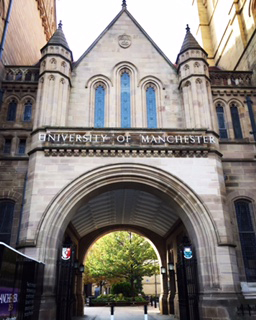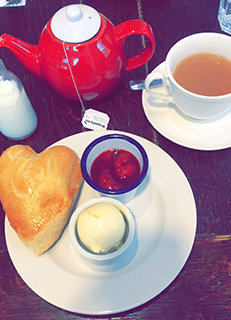CMU student collaborates abroad
Madeleine Kelly recently spent two weeks at the University of Manchester in England collaborating with researchers on a powerfully unique microscope. There are only a few of them in the world, and one of them is housed at Carnegie Mellon, where Kelly uses it to research ceramic materials.
Madeleine Kelly, Ph.D. candidate in materials science and engineering (MSE), had always wanted to study abroad. However, during her time as an undergraduate at Carnegie Mellon University, she decided that it wouldn’t work with her course schedule as she pursued a double major in MSE and Engineering and Public Policy. Now as a graduate student, she wanted to realize that goal.
“In grad school, I wanted the opportunity to do a collaboration abroad or go to different conferences where I could travel,” says Kelly. “I think traveling is a good opportunity to get out of your comfort zone and to work independently.”
Recently, Kelly spent two weeks at the University of Manchester in England, collaborating with researchers on the FEI HeliosTM PFIB Dual-Beam instrument. The powerful microscope is novel: there are only a few in the world. One of them is housed at Carnegie Mellon, where Kelly uses it to research ceramic materials.
Kelly received the Joseph Goldstein Scholar Award to help fund her experience in Manchester. The award is sponsored by the Meteoritical Society and the publisher Springer. It is intended to promote career advancement for early career members of the Microanalysis Society, increase interactions of junior and established microanalysts, and to advance the state-of-the-art in microanalysis measurements. The parts of the trip that were not covered by the award were off-set by a grant through Kelly’s advisor, MSE Professor and Department Head Greg Rohrer.
Only a few microscopes like the PFIB dual-beam exist, so collaborations are helpful in exchanging techniques for data collection and trouble-shooting certain software glitches. In Manchester, Kelly worked with Grace Burke, the director of the Materials Performance Centre, and Xiangli Zhong, the experimental officer for the FEI HeliosTM PFIB Dual-Beam.
“At the University of Manchester, I not only learned a lot from the experts of the FEI HeliosTM PFIB Dual-Beam,” says Kelly, “but I was also able to teach them about processing three-dimensional data and show them some statistical characterization that can be done on three-dimensional volumes. Xiangli Zhong taught me many techniques for electron microscopy.”
This experience abroad was completely unique. I was able to go somewhere else to do research, find different collaborations, and use an instrument hands-on.
Madeleine Kelly, Ph.D. candidate, Materials Science and Engineering, Carnegie Mellon University
Kelly realized she wanted to pursue a Ph.D. while working in a lab for an energy start-up company. She then applied and was accepted to Carnegie Mellon. Although she knew she wanted to pursue research in a lab, she did not know she wanted to study ceramic materials using the PFIB Dual-Beam until she heard about the project from Professor Rohrer. Now, she has been across the world to collaborate with other researchers at the top of the field.
“This experience abroad was completely unique,” says Kelly. “It was different from something like a conference where I might only have the chance to present my research. Instead, I was able to go somewhere else and actually do research, find different collaborations, and use an instrument hands-on.”




